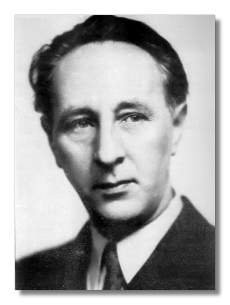Bohuslav Martinů

(1890 – 1959)
Bohuslav Martinů (December 8, 1890 – August 28, 1959) was born in a small Czech village. He studied briefly at the Prague Conservatory before he flunked out. No one ever called him a great student. He managed to become not only the greatest Czech composer of his generation, but a major international figure, known especially for his concerti and chamber music. His work tends to command attention from its opening bars. Its rhythmically vital and singing style recalls both Antonín Dvořák and Igor Stravinsky.
Martinů began as a follower of Claude Debussy, a rather eccentric choice in the Prague of that time – the major figures having been Dvořák and Richard Strauss. The works, culminating in the ballet Istar, are good, but not terribly individual or memorable. From about 1918 through the 1920s, Martin worked hard to discover his true artistic self.
He moved to Paris and became part of the avant-garde there. He experimented with jazz, a Bartókian rhapsodic style, and neoclassic fun-and-games in the manner of Les Six. The work is witty, highly musical, but again not individual. Occasionally, however, the “real” Martin peeks out. Significantly, it comes when he deals with Czech culture or with chamber music. The early choral Czech Rhapsody, the Three Czech Dances for two pianos, and the Duo No. 1 for violin and cello hint at works written twenty years later.
He comes more and more under the influence of Stravinsky, but unlike many others becomes less like Stravinsky and more Czech. Perhaps he saw the relation of Russian folk music to Stravinsky’s highly sophisticated and knowing musical approach and figured out his artistic salvation. Whatever, Czech folk influences become subject to a neoclassical musical view. At this point, we get such works as the Suites for string orchestra, Inventions for orchestra, the first cello concerto, the concerto for string quartet and orchestra, the second piano concerto, the concertino for piano trio and orchestra, and the opera Miracle of Our Lady. The period culminates in the late 1930s with such powerful works as the opera Julietta, the cantata Bouquet of Flowers, Tre Ricercari, and the relentless Double Concerto for two string orchestras, piano, and timpani.
During World War II, Martinů fled to the United States. His work opened up emotionally, without losing its considerable craft. He became a major twentieth-century symphonist, writing four works in this genre during the war (he ended up with six). In this period, the work sings like it never did before or since. Outstanding works include the Symphony No. 4, Violin Concerto No. 2, Cello Concerto No. 2, Field Mass, Memorial to Lidice, the piano quartet, Violin Sonata No. 3, and the trio for flute, cello, and piano.
The postwar period renewed his interest in vocal music. It includes such pieces as The Prophecy of Isaiah and The Epic of Gilgamesh and culminates in his opera on Kazantzakis’s The Greek Passion. The two major orchestral works of this last phase are his sixth symphony and Three Frescoes of Piero della Francesca. ~ Steve Schwartz
http://www.classical.net/music/comp.lst/martinu.php
Conflict and Conversion in Bohuslav Martinů’s “The Greek …
The Greek Passion by Bohuslav Martinu – What ever it may

